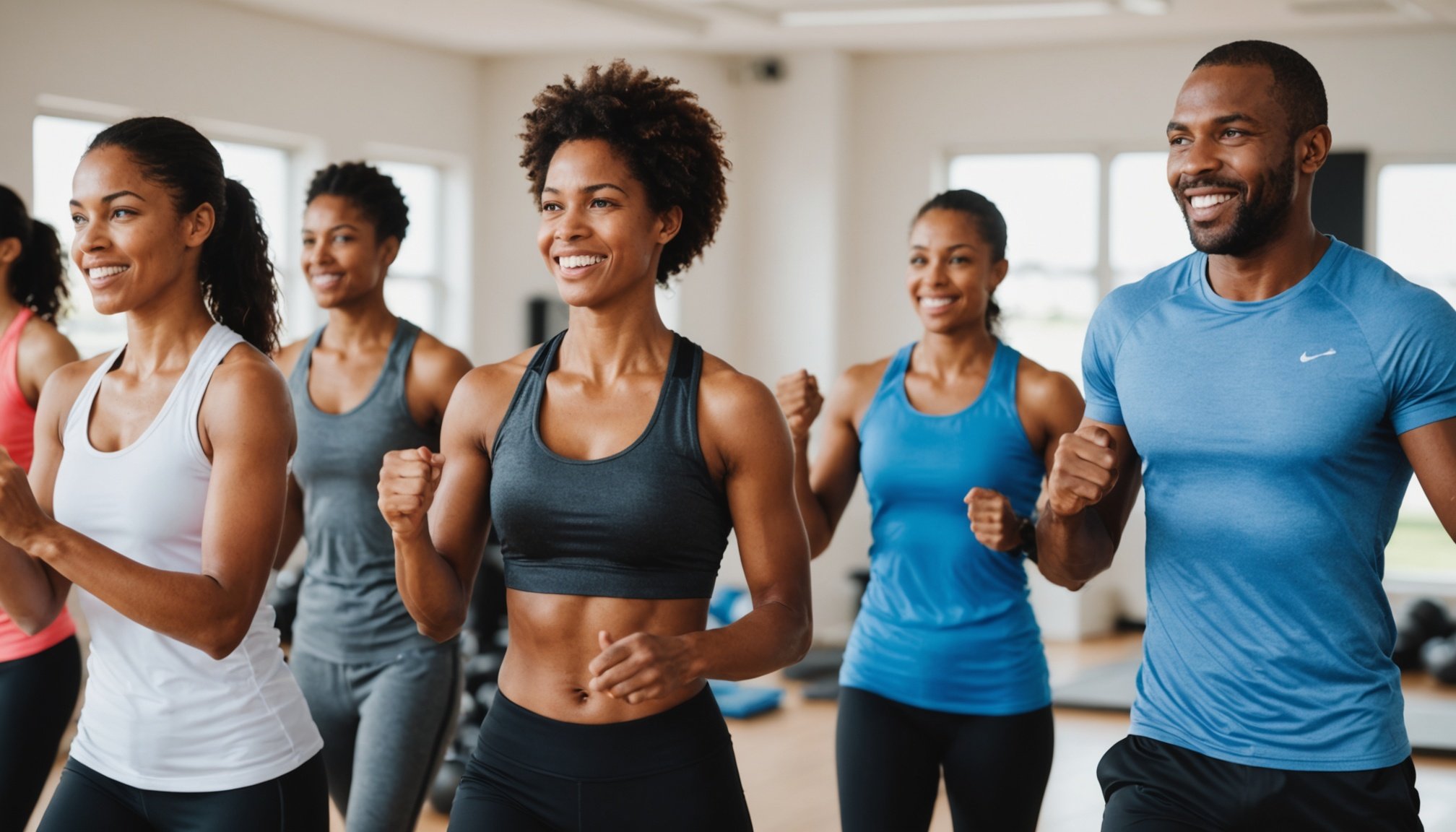Overview of Group Fitness Classes in the UK
Group fitness classes in the UK are a popular way to stay active and social. They encompass various activities, including yoga, pilates, spinning, HIIT, and dance. These classes provide instructors who guide participants through structured workouts, ensuring the activities are accessible for all fitness levels.
The landscape of group fitness in the UK has evolved significantly, especially post-pandemic. During lockdowns, many people discovered the benefits of online fitness classes, leading to a surge in virtual group fitness options. As restrictions lifted, hybrid models combining in-person and online classes became the norm. This flexibility has allowed for an increase in overall participation.
Also to see : Unleash Full-Body Fitness: How UK Indoor Climbing Gyms Boost Your Workout Potential
Demographics within these classes are diverse. Both men and women participate, although women are slightly more dominant in number. Age-wise, younger adults, particularly those aged 18-34, are the most frequent attendees, drawn by innovative UK fitness trends. However, the inclusivity of group classes means that older adults and those entirely new to fitness are also well-represented. Fitness levels vary widely; classes cater to beginners and offer modifications to challenge more advanced participants. This variety ensures a welcoming environment for everyone looking to join the world of group fitness.
Motivational Benefits of Group Fitness Classes
Participating in group workouts can significantly enhance your fitness motivation. The psychological boost of exercising in a shared environment is profound, as the presence of others can drive individuals to push beyond their perceived limits. When surrounded by fellow fitness enthusiasts, the social influence leads to an increase in motivation through accountability and shared goals.
Also to read : Exploring Effective Non-Pharmaceutical Approaches to Chronic Pain Management in UK Adults
Research underscores the numerous benefits of group workouts by highlighting greater adherence to fitness objectives. A pivotal study found that individuals attending group fitness classes are more likely to stick with a routine compared to those who exercise alone. The communal atmosphere encourages consistency, providing the motivation needed to persist even when enthusiasm wanes.
Comparing the motivation levels between solo workouts and group classes reveals a clear advantage for the latter. In a group setting, the energy and support from peers often result in heightened exertion and enjoyment. Additionally, the structured nature and variety of group classes prevent monotony, reducing the drop-out rate that is common in solo fitness regimens.
Overall, by tapping into the dynamic and supportive environment of group fitness, individuals can substantially amplify their motivation and commitment to their health and wellness goals.
Social Dynamics and Community Support
Social interaction plays a pivotal role in enhancing motivation and participation in fitness activities. When individuals engage in community fitness programs, they are often more excited to work out consistently. The engaging nature of group fitness classes makes participants feel part of a collective effort, driving everyone to strive towards their goals.
Many participants share testimonials describing the strong sense of community they’ve experienced. It’s common to hear stories about how these interactions lead to lasting friendships and stability in their fitness journey. The camaraderie felt in group settings often translates into positive emotional support, which encourages members to attend regularly.
The impact of group classes extends beyond just fitness; they foster an environment where people can build networks. This aspect of community and group support often leads to a strong sense of belonging and well-being. When people feel connected, they are more inclined to persist in their health pursuits, thus increasing the likelihood of achieving their long-term fitness goals. Overall, the power of social dynamics in fitness settings not only improves physical health but also supports mental and emotional resilience.
Inclusivity in Group Fitness Classes
Creating an environment of inclusivity in group fitness is vital for promoting accessible fitness to diverse groups. This approach acknowledges various abilities, ensuring that everyone can participate and benefit from fitness activities.
One significant strategy is designing classes to accommodate different skill levels. Offering variations of exercises during sessions can help cater to personal needs, making fitness more accessible. Instructors trained in recognizing and understanding diverse ability levels can further enhance inclusivity.
Moreover, fostering a welcoming atmosphere is crucial. This involves paying attention to language and communication, promoting a non-judgmental space where all participants feel comfortable and accepted. Incorporating feedback from participants can lead to more tailored and inclusive experiences.
There are excellent examples in the UK of inclusive programs that demonstrate these principles effectively. For instance, some gyms have implemented initiatives like “all-abilities” classes, which adjust intensity and exercises for a variety of participants. These sessions frequently showcase how thoughtful execution can lead to a genuinely inclusive environment.
By focusing on inclusivity, fitness classes can successfully reach and engage diverse groups, enhancing the overall experience and results for everyone involved.
Strategies to Increase Participation in Group Fitness Classes
Increasing participation in group fitness classes requires a keen understanding of effective engagement strategies and astute fitness marketing. Attracting new participants can be fostered through dynamic marketing techniques. Utilising social media platforms and community events to promote classes are effective methods for reaching potential attendees. Highlighting unique class offerings or special promotions can also pique interest.
Innovations in class offerings play a significant role in maintaining and boosting participation levels. Catering to diverse interests by incorporating emerging fitness trends or hybrid class formats can appeal to a broader range of individuals. These innovative offerings not only retain current attendees but also attract new demographics seeking varied fitness experiences.
Lastly, the importance of feedback and adaptability cannot be overstated when improving class experiences. Soliciting participant feedback helps instructors refine classes, ensuring they remain enjoyable and effective. This two-way communication fosters a sense of community, making participants feel valued and more likely to remain engaged.
By adopting a holistic approach that combines strategic marketing, innovative offerings, and adaptive feedback, fitness organisations can successfully increase participation and create vibrant, thriving class environments. Such engagement strategies ultimately lead to sustained participation and community growth.
Expert Opinions and Evidence-based Insights
Group fitness classes have become a cornerstone of modern fitness culture, drawing on both expert insights and robust evidence to support their effectiveness. Fitness professionals often highlight the psychological advantages of participating in group classes, particularly the boost in motivation stemming from motivational science. This is primarily because the social environment promotes accountability and a sense of community, which can be incredibly motivating for participants.
Numerous fitness research studies support the mental health benefits of group workouts. These studies consistently show a link between collective exercise and improved mood, reduced stress, and enhanced overall mental well-being. For example, statistical evidence suggests that individuals who engage in regular group fitness activities report higher levels of satisfaction and lower levels of anxiety compared to those who exercise alone.
Further analysis of existing research underscores the motivational factors inherent in group fitness. The structured nature of classes, combined with the supportive community, encourages participants to push past personal barriers, leading to more effective workouts and sustained physical activity over time. Such evidence-based insights reveal the profound impact that group fitness can have not only on physical health but also on emotional and psychological well-being.
Case Studies and Testimonials
Real-life examples play a crucial role in understanding the impact of fitness classes. They provide direct insights into experiences and outcomes that resonate with participants on a personal level. One compelling participant story highlights Karen, who, after joining aerobics classes, significantly improved her cardiovascular health and social connections. Motivated by the support and energy of her peers, Karen’s narrative is a powerful testament to the success narratives shared by others in similar environments.
Another important aspect is the case study of how community engagement flourishes through these group settings. For instance, the Greenwood Community Centre implemented martial arts sessions which not only enhanced physical fitness but also fostered a sense of partnership among its members. Such shared experiences turned acquaintances into friends, reinforcing the importance of collective motivation.
Moreover, success narratives from fitness instructors provide insightful lessons on participant motivation and retention. One instructor, Jenna, emphasizes creating inclusive and adaptive class structures that cater to diverse skill levels. By setting achievable goals and celebrating small victories, Jenna fosters an environment where motivation thrives, and retention follows naturally. These stories highlight the multifaceted benefits of group fitness, driving both individual and communal growth.











